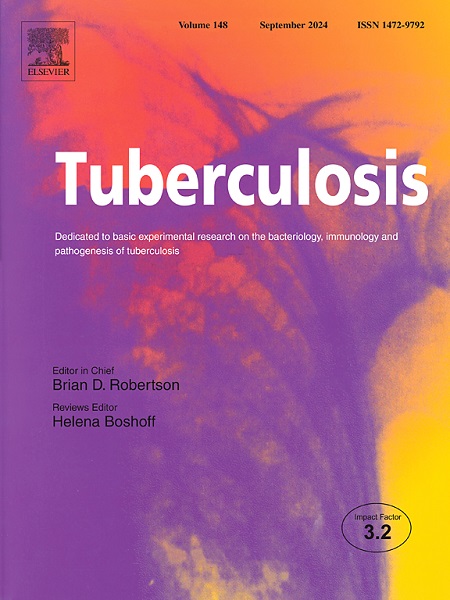Reduced host cell-free DNA as a biomarker in latent tuberculosis infection among tuberculosis contacts
IF 2.9
3区 医学
Q3 IMMUNOLOGY
引用次数: 0
Abstract
Objectives
Circulating cell-free DNA (cfDNA), including mitochondrial cfDNA (mt-cfDNA) and nuclear cfDNA (nu-cfDNA), are potential biomarkers for infectious diseases. However, cfDNA variations in TB contacts with latent tuberculosis infection (LTBI) and their potential link to a predominance of M1 monocyte polarization in LTBI remain unexplored.
Methods
Contacts of TB patients were screened for LTBI using the Interferon gamma (IFN-γ) release assay. Blood cfDNA was extracted, and mt-cfDNA and nu-cfDNA copy numbers were quantified by qPCR. cfDNA levels in the supernatant of M1-polarized THP-1-derived macrophages were measured.
Results
Levels of mt-cfDNA and nu-cfDNA were lower in the LTBI group (n = 76) than in the uninfected group (n = 58) (p = 0.012, and p < 0.001). The results were consistent in an age- and sex-matched analysis (n = 41 pairs). mt-cfDNA and nu-cfDNA levels were negatively associated with the TB-specific IFN-γ response (p = 0.009, p < 0.001). In the LTBI group, mt-cfDNA was negatively associated with the index case's bacterial burden (p = 0.045). In cell model, mt-cfDNA and nu-cfDNA levels in the supernatant from M1-polarized macrophage were lower than those from M2-polarized cells (p = 0.030, p = 0.045).
Conclusions
TB contacts with LTBI had lower cfDNA levels, which correlated with index case infectivity. Reduced cfDNA in M1-polarized macrophages warrants further investigation into the mechanisms of cfDNA reduction in LTBI.
减少宿主无细胞DNA作为结核接触者潜伏性结核感染的生物标志物
目的循环游离细胞DNA (cfDNA),包括线粒体cfDNA (mt-cfDNA)和核cfDNA (nu-cfDNA),是潜在的传染病生物标志物。然而,cfDNA在结核接触者潜伏性结核感染(LTBI)中的变异及其与LTBI中M1单核细胞极化优势的潜在联系仍未被探索。方法采用干扰素γ (IFN-γ)释放法对接触者进行LTBI筛查。提取血cfDNA,用qPCR法定量mt-cfDNA和nu-cfDNA拷贝数。检测m1极化thp -1衍生巨噬细胞上清液中cfDNA水平。结果LTBI组(n = 76) mt-cfDNA和nu-cfDNA水平低于未感染组(n = 58) (p = 0.012, p <;0.001)。在年龄和性别匹配分析(n = 41对)中,结果是一致的。mt-cfDNA和nu-cfDNA水平与结核病特异性IFN-γ反应呈负相关(p = 0.009, p <;0.001)。在LTBI组中,mt-cfDNA与指示病例的细菌负担呈负相关(p = 0.045)。在细胞模型中,m1极化巨噬细胞上清中mt-cfDNA和nu-cfDNA水平低于m2极化细胞(p = 0.030, p = 0.045)。结论stb与LTBI接触者cfDNA水平较低,与指示病例感染相关。m1极化巨噬细胞中cfDNA的减少值得进一步研究cfDNA减少在LTBI中的机制。
本文章由计算机程序翻译,如有差异,请以英文原文为准。
求助全文
约1分钟内获得全文
求助全文
来源期刊

Tuberculosis
医学-呼吸系统
CiteScore
4.60
自引率
3.10%
发文量
87
审稿时长
49 days
期刊介绍:
Tuberculosis is a speciality journal focusing on basic experimental research on tuberculosis, notably on bacteriological, immunological and pathogenesis aspects of the disease. The journal publishes original research and reviews on the host response and immunology of tuberculosis and the molecular biology, genetics and physiology of the organism, however discourages submissions with a meta-analytical focus (for example, articles based on searches of published articles in public electronic databases, especially where there is lack of evidence of the personal involvement of authors in the generation of such material). We do not publish Clinical Case-Studies.
Areas on which submissions are welcomed include:
-Clinical TrialsDiagnostics-
Antimicrobial resistance-
Immunology-
Leprosy-
Microbiology, including microbial physiology-
Molecular epidemiology-
Non-tuberculous Mycobacteria-
Pathogenesis-
Pathology-
Vaccine development.
This Journal does not accept case-reports.
The resurgence of interest in tuberculosis has accelerated the pace of relevant research and Tuberculosis has grown with it, as the only journal dedicated to experimental biomedical research in tuberculosis.
 求助内容:
求助内容: 应助结果提醒方式:
应助结果提醒方式:


